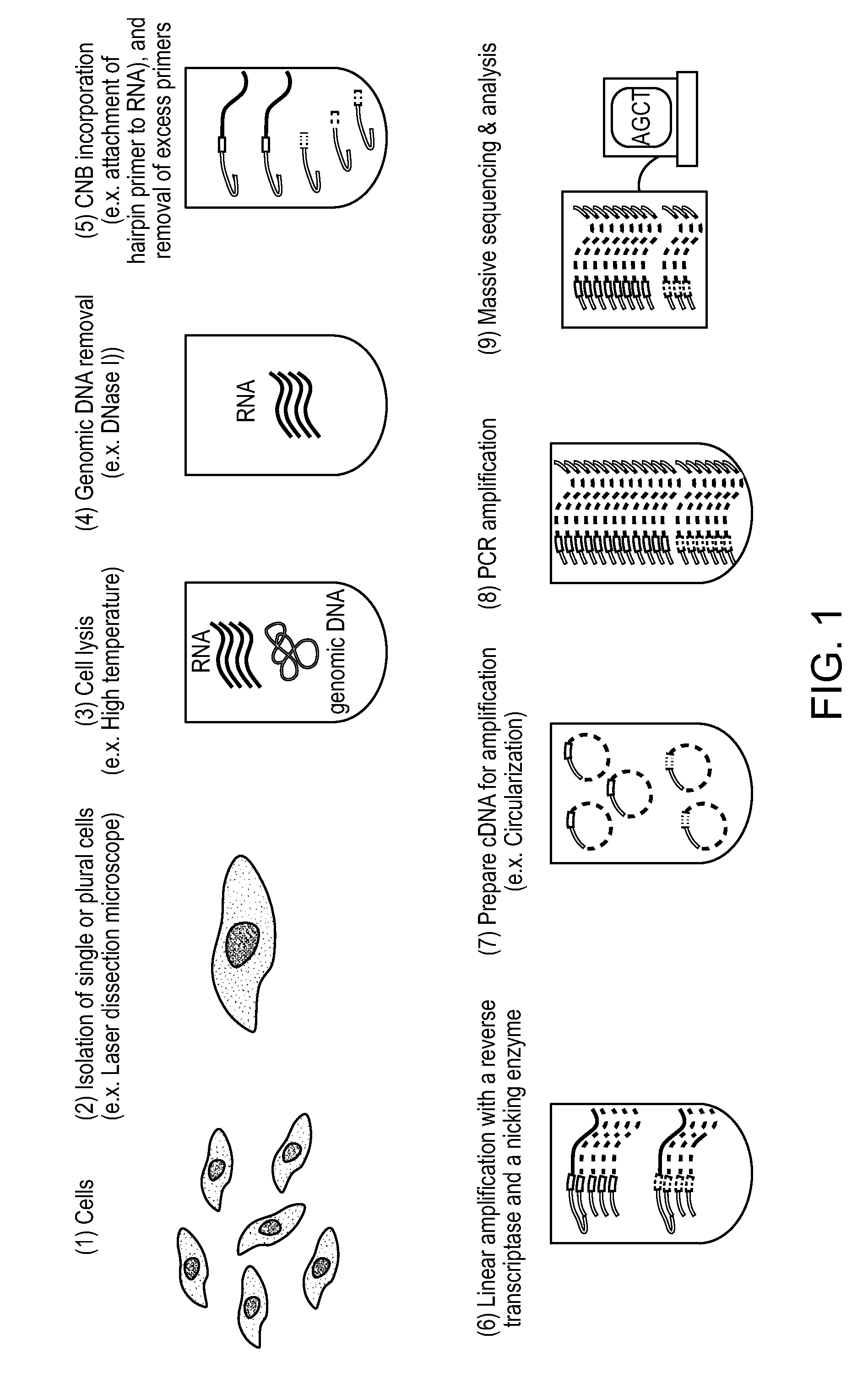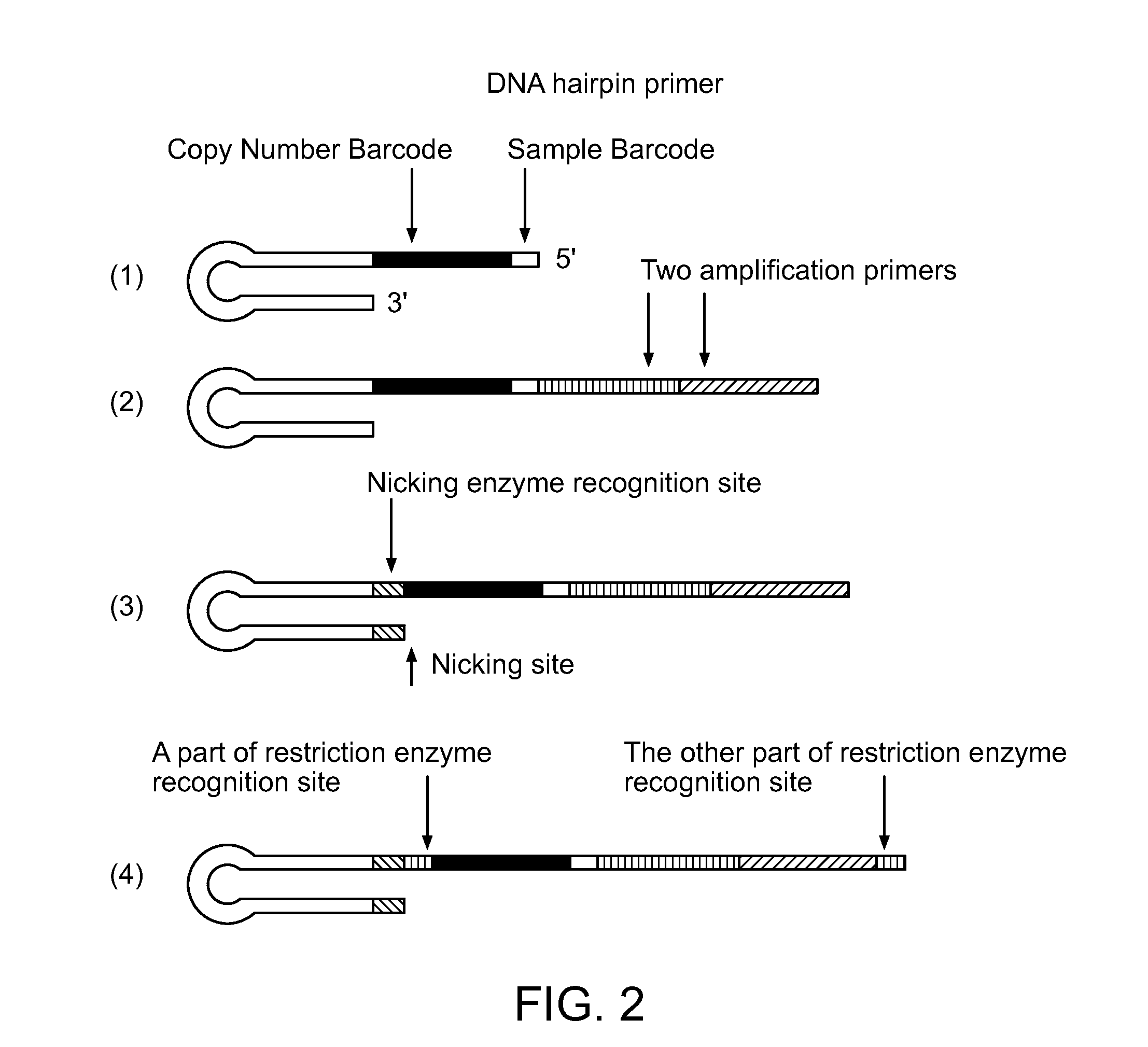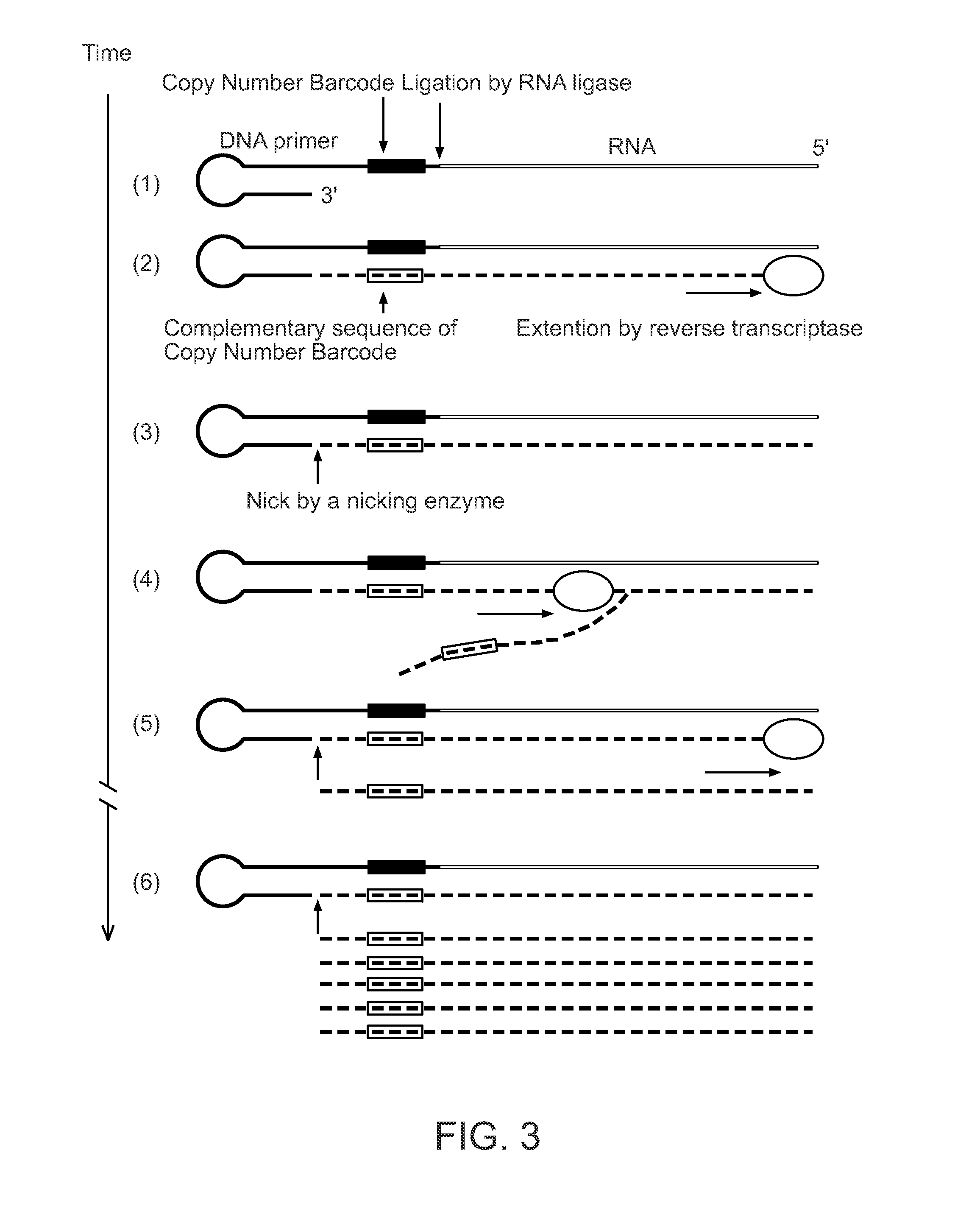Single Cell Nucleic Acid Detection and Analysis
a detection method technology, applied in the field of single cell nucleic acid detection and analysis, can solve the problems of false data regarding the number of nucleic acid molecules in a particular sample, detection difficulty, etc., to improve the efficiency of amplification and detection, improve the efficiency of reverse transcription of rna to cdna, and accurate count of the number to rna molecules
- Summary
- Abstract
- Description
- Claims
- Application Information
AI Technical Summary
Benefits of technology
Problems solved by technology
Method used
Image
Examples
example i
Single Cell RNA Quantification with Copy Number Barcodes
Cell Selection by Laser Dissection Microscopy
[0141]Prior to cell selection, the intracellular RNA is stabilized by adding 0.5 mL of RNALater (Ambion) to every 0.1 mL of cell culture. A cell is then selected, cut from a culture dish, and dispensed in a tube using a laser dissection microscope (LMD-6500, Leica). The cells are plated onto a membrane-coated culture dish and observed using bright field microscopy with a 10× objective (Leica). A UV laser is then used to cut the membrane around an individually selected cell such that it falls into the cap of a PCR tube containing 20 μL of buffer. The captured cell is then thermally lysed.
Genomic DNA Removal
[0142]Genomic DNA can be removed from the sample by the addition of 1 μL of 0.1 U / μL DNase I (New England BioLabs) and incubation at 37 C for 15 minutes. The reaction is the quenched by the addition of EDTA to a final concentration of 5 mM and heat inactivation at 75 C for 10 minute...
example ii
DNA Quantification Using Copy Number Barcodes
[0150]Eight DNA template oligos (135 bases) were purchased from Integrated DNA Technologies along with two primers:
Template A:(SEQ ID NO: 2)5′-ACAGGTTCAGAGTTCTACAGTCCGACGATCAGCTNNNNNNNNNNNNNNNNTGGTGGAGCTGGCGGGAGTTGAACCCGCGTCCGAAATTCCTACATCCTCGGTACTACATGGCCGTCGTATGCCGTCTTCTGCTTG-3′Template B:(SEQ ID NO: 3)5′-ACAGGTTCAGAGTTCTACAGTCCGACGATCAGCTNNNNNNNNNNNNNNNNTCGGGCCGGGGGTTGGGCCAGGCTCTGAGGTGTGGGGGATTCCCCCATGCCCCCCGCCGTGCCGTCGTATGCCGTCTTCTGCTTG-3′Template C:(SEQ ID NO: 4)5′-ACAGGTTCAGAGTTCTACAGTCCGACGATCAGCTNNNNNNNNNNNNNNNNTTATAAATACCGGCCCCGGCGGAAAACCAAGACGCTCATGAAGAAGGATAAGTACACGCTGCCGTCGTATGCCGTCTTCTGCTTG-3′Template D:(SEQ ID NO: 5)5′-ACAGGTTCAGAGTTCTACAGTCCGACGATCAGCTNNNNNNNNNNNNNNNNCGCCGCGGGGTGCACCGTCCGGACCCTGTTTTCAGGGTCCGGACGGTGCACCCCGCGGCGGCCGTCGTATGCCGTCTTCTGCTTG-3′Template E:(SEQ ID NO: 6)5′-ACAGGTTCAGAGTTCTACAGTCCGACGATCAGCTNNNNNNNNNNNNNNNNCAAGCAGAAGACGGCTCCGGGACCGTCCGGACCCTGTTTTCAGGGTCCGGACGGTCCCGGGCCGTCGTATGCCGTCTTCTGCTTG-3′Templat...
example iii
Generation of a Genomic Primer Pool with Copy Number Barcodes
[0158]Genomic DNA is fragmented using Fragmentase (New England Biolabs) by combining 5 μg of purified genomic DNA (FIG. 4B), 10 μL of NEBNext dsDNA Fragmentase, 1× NEBNext dsDNA Fragmentation Reaction Buffer (New England Biolabs), and 0.1 mg / mL BSA in a final volume of 100 μL. The reaction mixture is then incubated at 37 C for 30 minutes, quenched by the addition of 100 mM EDTA, purified on a DNA purification column (Zymo Research), and eluted in a final volume of 35 μL. FIG. 4B depicts an electrophoretic gel in which samples taken from different time points in the Fragmentase reaction were run in different lanes of the gel. The first and second lanes contain standard DNA ladder sequences, and the third, fourth, and fifth lanes contain samples taken 20 minutes, 30 minutes, and 40 minutes from the initiation of DNA fragmentation, respectively. The gel shows that the average DNA length in the sample decreases as the reaction...
PUM
| Property | Measurement | Unit |
|---|---|---|
| Tm | aaaaa | aaaaa |
| melting temperatures | aaaaa | aaaaa |
| melting temperatures | aaaaa | aaaaa |
Abstract
Description
Claims
Application Information
 Login to View More
Login to View More - R&D
- Intellectual Property
- Life Sciences
- Materials
- Tech Scout
- Unparalleled Data Quality
- Higher Quality Content
- 60% Fewer Hallucinations
Browse by: Latest US Patents, China's latest patents, Technical Efficacy Thesaurus, Application Domain, Technology Topic, Popular Technical Reports.
© 2025 PatSnap. All rights reserved.Legal|Privacy policy|Modern Slavery Act Transparency Statement|Sitemap|About US| Contact US: help@patsnap.com



